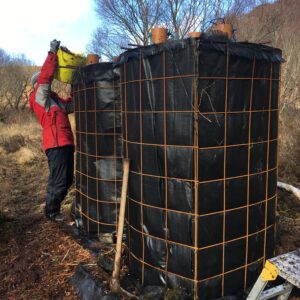
Wild Soils. Why understanding our soil matters in ecological restoration projects.
Wild Soils.
In a healthy soil that has not suffered from agricultural ‘improvement’ there is a microscopic web of life that supplies the optimal range of nutrients to our plants and prevents excess soluble nutrients from accumulating.

In these pristine soils, nature has ensured there is no wasteful leaching of nutrients into water courses and instead holds them in living biomass and complexes them into more stable forms.
Through a near miraculous process, bacteria solubilise minerals using enzymes from the crystalline structures in the rock accessing a wide pool of nutrients that are unavailable to plants to take up directly.
Every soil in the world has a ‘total pool’ of nutrients locked up in rocks that has the potential to provide enough nutrients for all plants forever. It’s inexhaustible.
In a higher successional soil where there are a wide range of plant species growing, each plant produces liquid carbon in the form of exudates as they photosynthesise. The cocktail of exudates is mixed by the plant to attract specific organisms to the plant’s rhizosphere where they can feed on this free food. The microscopic hive of activity around the root zone attracts the predators of these organisms who inevitably join in the feast. When the predators eat the bacteria and fungi they pass excretions and leave necromass that releases nutrients (previously absorbed from the rocks) in a plant available form – right next to the plants roots ready for absorption.
This incredible symbiotic process can take as little as three seconds and happens in perfect balance, with no wastage, driven only by sunlight.
If anything happens to disturb the state of our soil biology such as tillage, the use of fertilisers, wormers and medicines for livestock, application of herbicides, or the saturation of our soil, this delicate ‘microbial bridge’ breaks down.

If fertilisers (including applications of farm yard manure) are used, the plant will start to take the easier option of directly absorbing the soluble nutrients without the sacrifice of ‘giving away’ exudates into the root zone. Without their carbon source, the organisms die off and microorganism complexity is reduced; no longer being able to support a high diversity sward.
The same problem occurs from above ground if the diversity of the sward has been reduced through reseeding with ‘productive grasses’ or through overgrazing. The lack of diversity in the exudates being produced leads to a lack of diversity in the microorganism community which results in a breakdown of the nutrient cycling capacity.
It’s not just overgrazing that hampers the healthy of our soil biology, it’s under-grazing too. Grasses co-evolved with herbivores and the very action of a grass plant being bitten, kick starts a communication between root and soil organisms so the plant can get the nutrients it needs to regrow its crown. In rank grassland photosynthesis is reduced, so the potential for plants to support a diverse underground army is hugely reduced.
If the microbes disappear or their complexity is reduced, the plants have to rely upon the severely limited soluble pool for their nutrients which constitutes only 1% of the total available nutrients in the soil.
Nearly every inch of the UK has been subjected to human influence. Even the woodlands and uplands we consider ‘wild spaces’ are changed beyond all recognition from the high successional fully functional ecosystems that included a wide range of large herbivores who’s grazing, and animal impact was influenced by large predators.
The ‘wild’ soils of these ecosystems probably performed nutrient cycling to a level we have never seen in the UK. But isn’t the potential of this limited situation an exciting prospect? We think so.

Many of our Wilderculture projects are designed to explore these questions;
- What additional biodiversity are our upland soils capable of supporting?
- What potential volume of biomass could be produced from habitats supported by these soils?
- Would these soils help our flora and fauna more resistant to disease?
- Would these soils sequester more carbon, oxidise more methane, be resistant to drought and prevent flood events?
We believe that we’ll only find the true potential of our soils when we fully mimic the functions of predated herbivores on the ecosystem. Only when we integrate grazing and browsing herbivores into woodland planting schemes and integrate woodland habitat into grazing systems will we see a successful stimulation of the soil microbiome to create truly wild soils. But passive grazing by a few ungulates isn’t enough to achieve a highly functional soil, we need to mimic the animal impact that would be achieved by animals in fear and recreate the optimal grazing patterns of herbivores hiding from predators; when there are no large predators present then it becomes our job to manage that behaviour change through holistic planned grazing. We become a ‘conscious’ key stone predator; perhaps the most important species in the ecosystem.
Caroline


No Comments